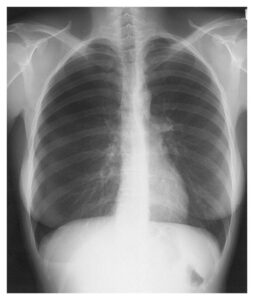This article is an answer to the Case – 87-year-old Man with Blue-Gray Pigmentation
This patient has minocycline-induced hyperpigmentation. Minocycline is a tetracycline derivative that is commonly used in the treatment of acne vulgaris and other inflammatory conditions, such as rheumatoid arthritis.
Patients usually tolerate minocycline very well due to the much lower incidence of gastrointestinal upset and sun sensitivity compared with other tetracycline derivatives.
Unfortunately, minocycline has several potentially dangerous side effects if taken for an extended period of time, including:
- minocycline hypersensitivity syndrome
- minocycline-induced lupus erythematosus
- hyperpigmentation
Minocycline has a highly lipid-soluble structure that turns black with oxidation. There are three distinct types of minocycline-induced hyperpigmentation.
Type I is the most common, with blue-black macules occurring at sites of prior inflammation including acne-related or post-surgical scars. The discoloration results from iron deposition in the dermis.
Type II presents with blue-black macules and patches on previously normal skin, most frequently the anterior lower extremities. The pigmentation may initially be mistaken for ecchymoses, especially in elderly patients, but the pigment does not fade to green-yellow as expected. This clinical presentation is due to a combination of iron and melanin deposition in the dermis.
Both types I and II occur three months to several years after minocycline initiation. Approximately 4% of patients taking the medication experience some degree of hyperpigmentation with a cumulative dose greater than 100 g.
Type III is the least common type of minocycline-induced hyperpigmentation, and presents with a muddy brown generalized discoloration with accentuation in sun-exposed areas. Type III produces increased melanin in the basal layer of the epidermis, as well as increased dermal melanophages, but no deposition of iron.
In addition to drug discoloration of the skin, minocycline may cause hyperpigmentation of the oral mucosa and teeth, sclera, conjunctiva, nails, bone, thyroid and ear cartilage. A gray to gray-green pigment may appear on the mid-portion of permanent teeth and may occur without concomitant skin involvement.
Diagnosis
Diagnosis of minocycline-induced hyperpigmentation is largely based on clinical presentation and patient history. Unfortunately, not all patients are good historians.
In this case, the patient’s records were obtained, and we were able to confirm that he had been on minocycline 100 mg bid for more than two years.
A skin biopsy may also be performed and would show increased brown dermal pigment that stains positively for iron, melanin or both.
Treatment
Minocycline-induced hyperpigmentation treatment is limited. Some improvement may be seen with the use of the Q-switched Ruby laser.
Discontinuing minocycline can result in very slow spontaneous resolution and may take several years. Complete resolution may not occur. Preventing minocycline-induced hyperpigmentation through judicious administration of the medication is strongly advised.
SIMILAR CASE: Blue–black eyes and legs

